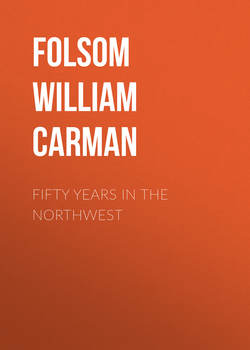Читать книгу Fifty Years In The Northwest - Folsom William Henry Carman - Страница 67
CHAPTER V.
BIOGRAPHIES
OSCEOLA
ОглавлениеOsceola contains all of township 33, range 18, except the eastern tier of sections, and ten whole sections and some fractions of range 19, made somewhat irregular by the St. Croix river boundary, and the obtrusion of three sections of Farmington in the southwestern part. It is a rich agricultural town, consisting chiefly of prairie, the whole forming a tableland, terminating westward on the precipitous bluffs of the St. Croix. It has a good steamboat landing and two good water powers, Osceola and Close's creeks. These are both fine trout brooks. The bluffs overlooking the St. Croix are bold and high, and, for a great part, precipitous. Most conspicuous of these bluffs is the promontory known as Eagle Point, situated just below the Osceola landing. An escarpment of limestone, about two hundred feet above the river, projects over its base, not much unlike the celebrated table rock at Niagara Falls. A tall and solitary pine tree stands upon the extreme verge of this rock, the whole forming a conspicuous landmark, visible to a distance of several miles down the river. The cascade on Osceola creek, a few rods above its mouth, has scarcely a rival amongst the waterfalls of the West. It has sometimes been called the Minnehaha of Wisconsin, but while it resembles somewhat in the lower part of its descent that celebrated cascade, the scenery around it is much wilder, perpendicular rocks towering over it to a great height, while the upper part of the fall is over an inclined plain, broken into steps. It is a favorite haunt for artists and photographers. There are several minor waterfalls of great beauty in the vicinity. The trap rock formation crops out in the eastern and northern parts of the town, rich in specimens of copper and silver. Silver is also found in ledges at East Lake.
The first land claim in the town, made May 14, 1844, by Milton V. Nobles and Lucius N. S. Parker, included the cascade and the present site of the village. The claim was made with the intention of building a saw mill at the outlet of Osceola creek. The mill company, organized in 1841, consisted of M. V. and W. H. Nobles, Wm. Kent, Wm. O. Mahony and Harvey Walker. Mr. Nobles sold his interest and removed to Willow River; Wm. Parker removed to St. Anthony. The mill commenced cutting timber in 1845. It was run at first with a small flutter wheel, which was replaced by a an overshot wheel, 30 feet; that by another, 45 feet, and that by one 50 feet in diameter. In 1845 the company built a two story boarding house, also a shop and office, near the mill. After the completion of the mill Walker withdrew from the firm and Anson Northrup was for a short time a member. Kent & Mahony for a number of years operated the mill, selling lumber in Galena and St. Louis. Mahony left for California in 1852. Around this mill, as a nucleus, the settlement of Osceola and the village were built up. The mill, with its immense water wheel, for so many years a conspicuous object on the river, has long since disappeared.
Osceola has had many enterprising business men engaged in merchandising and manufacturing. The first flouring mill was built by Kent Brothers in 1853, just above the cascade. This mill changed owners several times, and was burned in 1880. It was rebuilt by Lovejoy & Sutton in 1883. Its present capacity is one hundred barrels per day. The second flouring mill was built by Dresser & Wilson in 1867. It is situated on the same stream, a few rods above the first. It has also changed owners several times. Its capacity is fifty barrels per day. The first merchants were Wyckoff and Stevenson, in 1856. These have been succeeded by Rice, Webb, Clark Brothers, Armstrong & Co., Talboys & Staples, Dresser & Wilson, Lacy & Johnson, W. A. Talboys, Gridley & Co., Heald & Thing, Dresser Brothers, and others. Dr. Gray was the first practicing physician. After him, at different periods, came Drs. Hilton, Brooks, Gaskill, Garlick, Marshall, Searles, Cornbacker and Clark. The first deed recorded of Osceola property was a quitclaim from Wm. H. Nobles to Anson Northrup, consideration $3,250, in 1847. The first lawyer settled here was I. P. Freeland. His successors were Button, Dowling, Dyke, McDill, and others. The first sermon preached in Osceola was by Rev. Lemuel Nobles, a Methodist minister, in 1851. There are two church organizations; each has respectable church buildings. The first Baptist preacher was Rev. S. T. Catlin, in 1854. The Baptists built the first church in the county in Osceola, 1856. The first log house in the town was built by Richard Arnold in the locality of the famous Drake Troutmere springs. This house was built in 1848. Mr. Arnold raised the first crops in the town of Osceola. The first school house was built in 1852. A high school building was erected in 1868. W. A. Talboys taught the first public school in 1852. Until 1861 the schools were under the town system. In 1875 a free high school was established. The first post office was established in 1854, and W. C. Guild was postmaster for twenty years. The first town election was held April 5, 1853, when the following supervisors were elected: Wm. Ramsey, chairman; Nelson McCarty and W. C. Guild. At this meeting the town voted a tax of thirty dollars for school and fifty dollars for town expenses. The first Sunday-school was organized by W. A. Talboys in 1852.
The first marriage, that of John Buckley to Elizabeth Godfrey, was in 1853. The first white child born was John Francis, in 1847. The first death was that of Leroy Hubble, by accident, in 1845.
